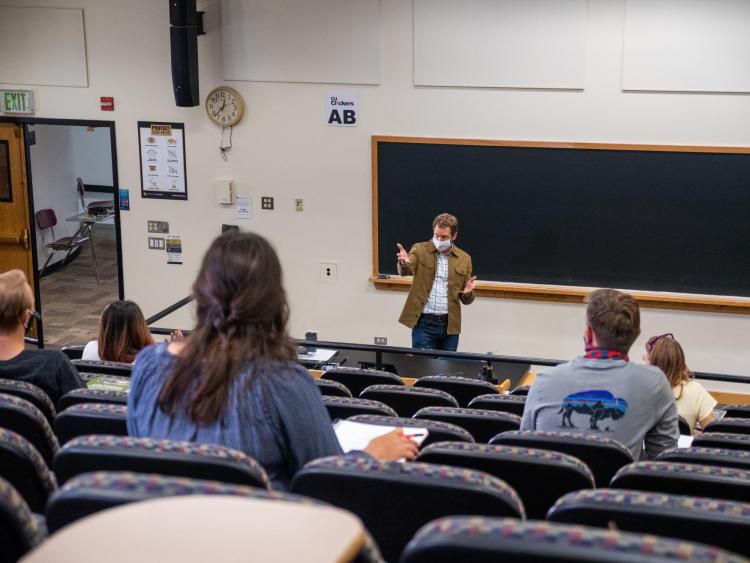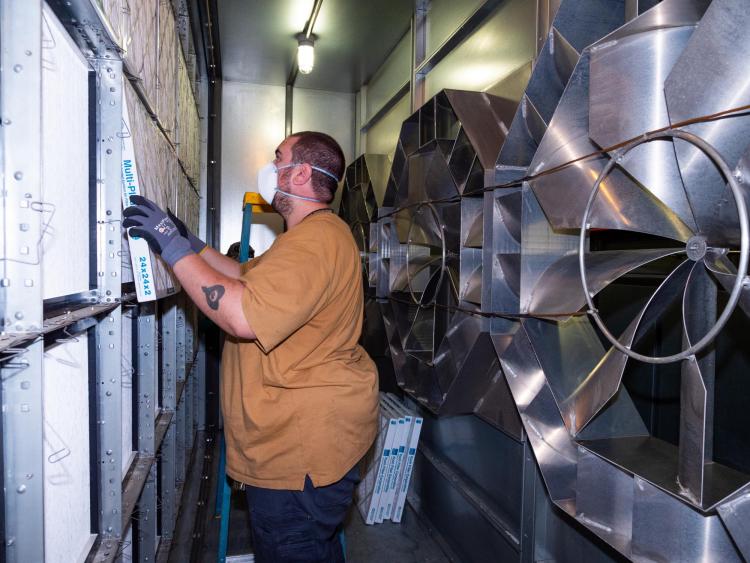Why better ventilation is key to limiting COVID-19 spread on campus
Banner image: Mark Palacio, Jr., preventative maintenance tech, replaces air filters in the Indoor Practice Facility on the CU Boulder campus. (Credit: Patrick Campbell/CU Boulder)
The CU Boulder campus is more like a city than a school—with roughly 13 million square feet of indoor area spread over lecture halls, offices, residence halls, dining facilities, cafés and even a bowling alley.
Preparing such a complicated environment for the arrival of thousands of students this month has been a Herculean task, and one that has raised tough questions: How many people can safely fit into a single classroom? How do you keep the air inside those rooms clean? How can the university minimize the number of students on campus at any given time?
A mostly behind-the-scenes team of university staff has been working around the clock for months to solve those issues. And these professionals have tapped new allies this year: CU Boulder’s world-class researchers.
Shelly Miller, a professor in the Paul M. Rady Department of Mechanical Engineering, has spent years studying the airborne transmission of diseases. This summer, she’s worked closely with campus facilities teams to ensure that students, faculty and staff can breathe the safest possible air.
“The general principle is that we want to dilute inside air with outside air,” Miller said.
To achieve that feat, the university formed a team called the Facilities Task Force, which includes participants from Facilities Management, Environmental Health and Safety, Housing and Dining Services, Athletics, Parking Services and more. These dedicated employees addressed safety measures for cleaning, building access, outdoor spaces and on-campus bus transit. They also reduced classroom capacities and converted dozens of alternative spaces like conference rooms into classrooms. And the group analyzed and upgraded every single ventilation system on campus—a way of bringing a bit more mountain air into indoor areas.
“It’s been the busiest summer that I’ve experienced,” said Chris Ewing, assistant vice chancellor for planning, design and construction.
The upgrades can’t stop the spread of COVID-19 on their own, he added, but when paired with mask wearing and other forms of social distancing, they may go a long way toward making campus safer in the fall.
A mad dash to prepare campus
For Shannon Horn, a mechanical engineer on the Facilities Management team, life has been a sprint since March.
When the pandemic began, she explained, scientists weren’t sure how the novel coronavirus even spread. Many suspected that it jumped from person to person via surfaces like door handles or tabletops. But a growing body of evidence suggests that the pathogen can also fly—or, at least, float through the air inside the tiny droplets of fluid, or aerosols, that people expel when they breathe or talk.
Miller and colleague Jose-Luis Jimenez, a professor of chemistry, have helped to lead a campaign to push the scientific community to recognize the airborne transmission of COVID-19. In July, they helped to write a letter to the World Health Organization to encourage a shift in the international body's public health guidance.
“I have been working on airborne infectious disease control since the 2000s when we had a resurgence of tuberculosis,” Miller said. “I have been arguing we need more ventilation to provide healthy indoor environments, but, usually, that falls on deaf ears.”
At least on campus, everyone has open ears now. To provide those healthy indoor environments, the Facilities Task Force first mapped out classrooms across campus to set new capacities based on physical distancing guidelines. Most of these spaces will now hold about 70 to 75% fewer students than they would in a normal year.
Then the group set its sights on ventilation. Horn explained that the more outside air you can bring inside, the more you can dilute out the aerosols that students will exhale during class time.
“Our goal is to minimize the impact that ventilation could possibly have on the spread of the virus,” Horn said.
Bringing outdoor air in
Over a period of months, she and her colleagues adapted every single ventilation system on campus. Whenever possible, Horn’s team upgraded the systems so that they pull in only new air from the outside rather than constantly recirculate indoor air. When that’s not possible, such as on especially cold days, the team installed top-of-the-line air filters called MERV 13 filters in ventilation ducts. These devices are capable of trapping particles in the air that can potentially carry viruses. Think of them like pasta strainers but for possible pathogens instead of noodles.
For naturally ventilated spaces, the group installed HEPA air filtration units to increase circulation and clean the air. Miller said that the project is a prime example of good science turning into action.
“We have so many buildings on campus and so many different kinds of buildings,” Miller said. “It’s incredibly complicated, and I applaud them for the effort they put in.”
Ewing notes that the biggest lever that the university has against COVID-19 is still its own community—from students to staff and faculty.
“All of this works as long as everyone is doing their part, which means masks, hand washing and distancing,” Ewing said.




